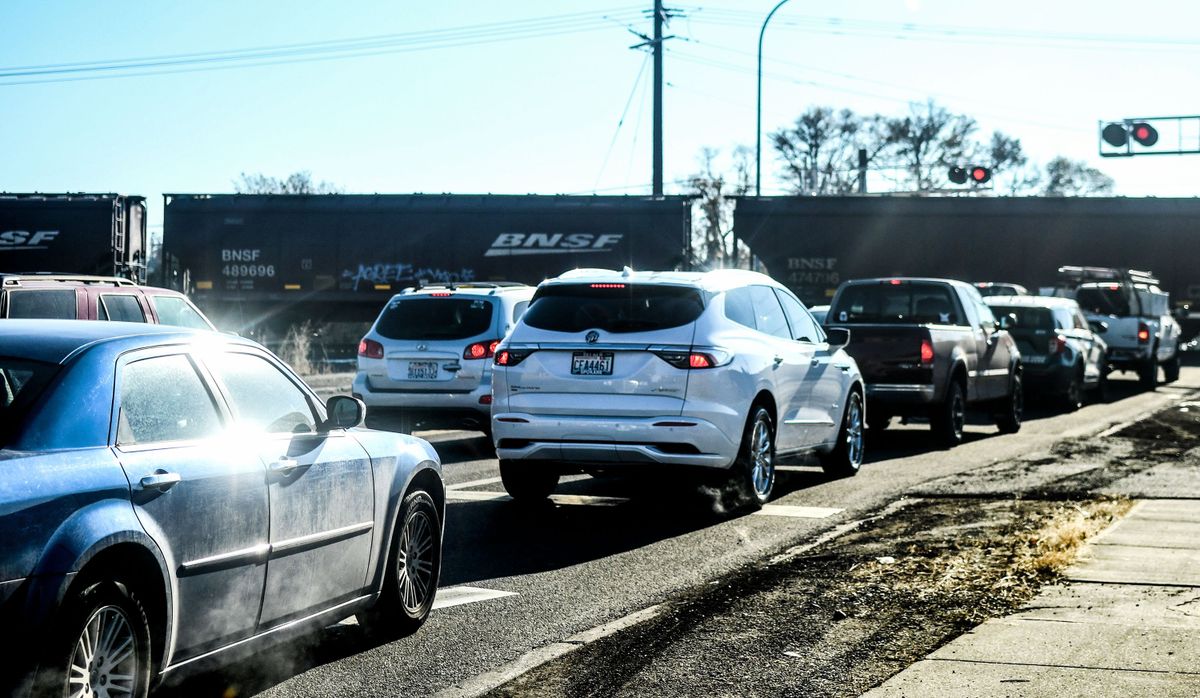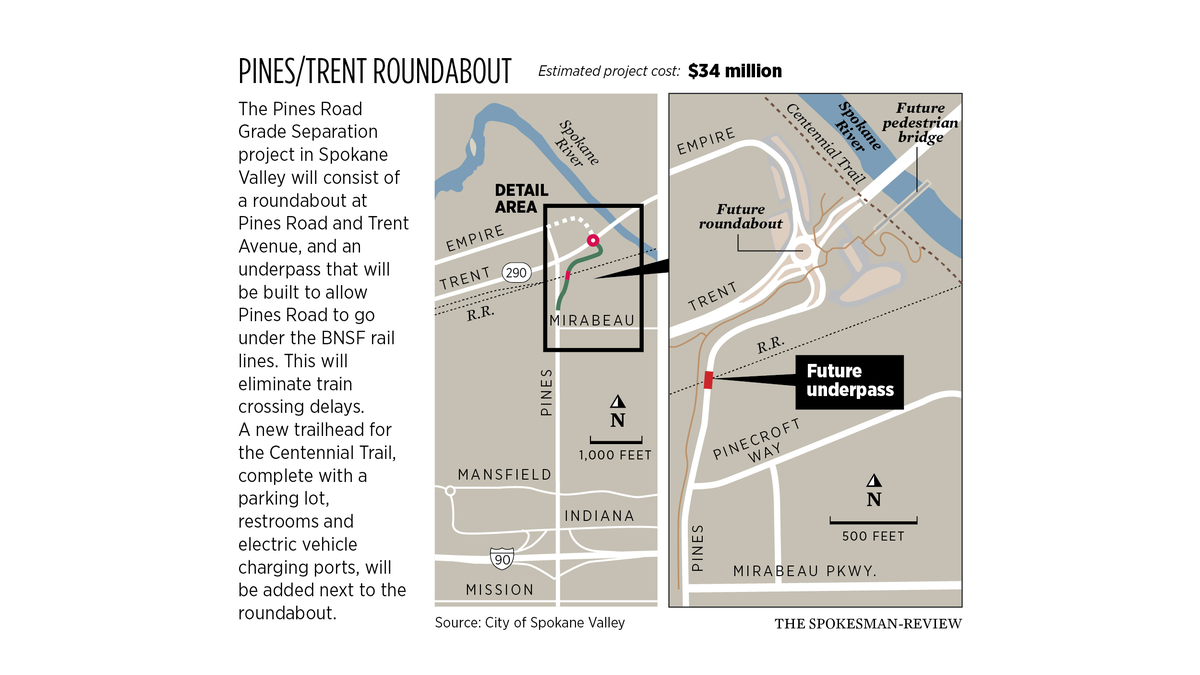Getting There: BNSF halts work in Spokane Valley, likely adding to delays for Pines Road project
Traffic is lined up at the railroad crossing at Trent Avenue and Pines Road in November. Spokane Valley may need to use eminent domain to acquire land needed to build an underpass that will eliminate delays at the crossing. (Kathy Plonka/The Spokesman-Review)Buy a print of this photo
A major public works project meant to alleviate traffic stoppages at one of the busiest railroad crossings in Spokane Valley has hit another hurdle.
The city is close to breaking ground at an underpass where BNSF train tracks cross Pines Road, and a roundabout at the Pines and Trent Avenue intersection, which would cut out the infuriating delays that cost drivers a cumulative four hours every day.
Spokane Valley has the funding for the project, with around $43 million secured through a combination of state and federal grants.
They’ve secured almost all of the necessary land, including more than $800,000 worth of land donated by Avista Utilities that will be used to build a new trailhead for the Centennial Trail complete with a parking lot, restroom facilities and an electric vehicle charging station.
The city is in the process of using eminent domain to seize control of the lone holdout property.
But the city has yet to finalize agreements with one of the main stakeholders of the project, BNSF, and the railway’s recent stoppages of their own work in the Valley means the city is facing new headaches in moving forward.
BNSF began work last year on a second track from Hauser, Idaho, to Spokane Valley, running parallel to its existing mainline, to accommodate the train traffic that’s expected to almost double by 2035. The project was going to include the construction of a second Spokane River bridge crossing and would connect with existing double tracks west of Pines Road.
That work has been put on hold, according to Erica Amsden, engineering manager for Spokane Valley.
The halt in construction means mounds of dirt and other related materials remain at the railway’s staging area at the corner of Trent and Pines, which could lead to a delay in the city beginning its own work in the area.
“At any time they can choose to restart that and that will affect our timeline,” Amsden told the Spokane Valley City Council last week.
Amsden said BNSF has stipulated that the staging area should be cleared before the city starts its roadwork for the Pines Road project, but the railway has not indicated when, or if, the double track project will continue, or when they expect to have the area cleared. The stipulation is part of the railway’s requirements for allowing the city right of way to BNSF’s land in the area.
“It’s their property, it’s at their discretion,” Amsden said in the meeting. “Right now we’ve been told they’re putting it on hold indefinitely and they don’t plan to restart, but we know they had stopped some other projects and then restarted them.”
In response to questions about the project from The Spokesman-Review, BNSF spokesperson Kendall Kirkham Sloan did not answer whether the project would be restarted or whether the staging area would be cleared in the near future.
The city is still in ongoing negotiations with the railway to have them construct the two bridges for the double tracks under which the underpass will be routed. Amsden said the railway has concerns over certain flow-down provisions relating to a more than $21.6 million federal grant that will reimburse the railway for construction of the bridges.
“Specifically, there was some concerns with the bridge construction by BNSF, and the federal grant provision,” Amsden said. “We just needed some clarity on that before we can proceed.”
BNSF declined to specify what those concerns were when asked by The Spokesman-Review.
Having the railway construct the bridges would mean significant savings for the city, Spokane Valley City Councilman Ben Wick said. The goal is to finalize agreements for the construction of the bridges and the use of BNSF land this spring so the railway can build the bridges this summer. The city’s road work would begin next year.
BNSF said in a statement that they are still working to meet that timeline.
When BNSF began their double-track work, they were forecast to be done well before the city started their roadwork, Wick said. The city would likely need to wait until 2026 to start road work if the railway doesn’t build the bridges until next year.
Wick said the Pines Road project involves much more stakeholder agreement from the railway than the city’s recently completed overpass on Barker Road, where the city handled most of the construction needed to raise the road above the tracks.
“With Pines, we’re looking to partner more with the railroad because they’re looking to build part of that project with their crews,” Wick said. “It’s going to be a win for us to partner with them with this one.”
There are also several utility relocations that need to be finished before the Pines Road project can move forward, Amsden said.
Phillips 66 has a high pressure gas main that runs parallel to the tracks that will need to be lowered and be realigned. The city would need to amend their current agreement with the company.
Avista has several electric and gas mains in the area that will need to be relocated, and the Irvin Water District has a new water main that will need to go in north of Trent.
All the utilities work, in addition to relocating communication lines for Lumen Technologies, Cogent (formerly Sprint), AT&T, Comcast, Verizon and Zayo, would need to be completed ahead of construction to avoid further delays.
Wick said he looks forward to the realization of the city’s vision of an underpass, roundabout and pedestrian access to the riverfront . It’s been a priority at City Hall for years and was part of the region’s ambitious Bridging the Valley effort, a largely unfulfilled proposal to eliminate train crossings between Spokane and Athol, Idaho.
“I can’t wait for that one to get going and be finished,” Wick said. “With the new trailhead access point there, it’s going to be great.”

